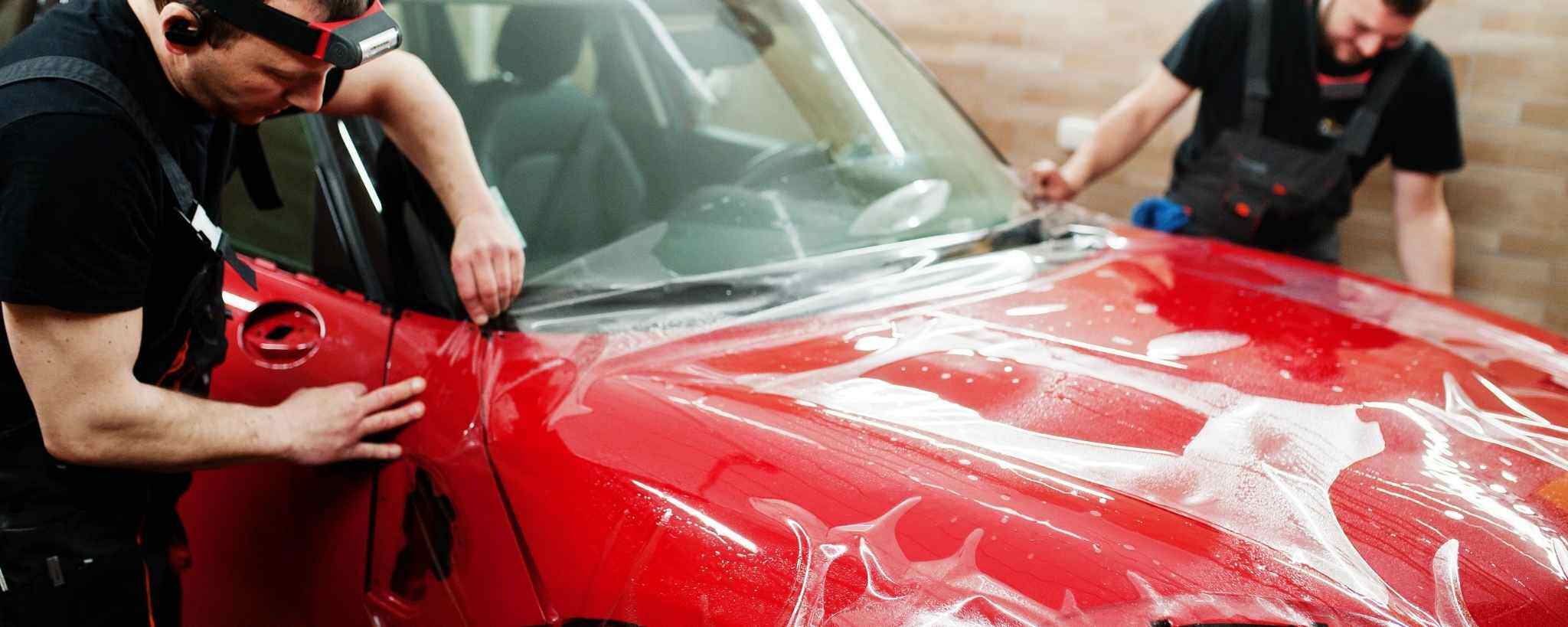9 Best Ways to Protect Car Paint from Sun Damage and Other Environmental Factors
Searching for the best way to protect your car paint? Check out expert tips on washing, waxing, and coatings to keep your car shiny and protected year-round!

Written by:
Parham Koukia
Reviewed By:
Editorial Team
Published: March 01, 2025
Updated: September 26, 2025
Use AI to summarize this article:
The car paint acts as a barrier against environmental damage, oxidation, and corrosion. Exposure to harsh UV rays, road salt, and acidic contaminants gradually breaks down the paint’s protective layers, leading to fading and deterioration.
Without proper care of your car’s paint, even routine professional detailing can become an expensive fix rather than a preventive measure. Many service providers charge significantly more for paint correction and restoration, which is why regular upkeep of car exterior becomes more important.
To help you with the best ways to protect your car paint, Panda Hub has some expert tips on car paint care:
Best Ways to Protect Car Paint
Regular Washing (The Right Way!)
Dirt, dust, and road grime don’t just make your car look dirty, they also cause long-term damage by embedding into the paint and leading to micro-scratches.
To properly wash your car:
- Use a pH-neutral car shampoo: Harsh detergents strip away protective coatings and accelerate paint oxidation.
- Choose microfiber wash mitts: Unlike sponges, microfiber prevents swirl marks and scratches.
- Rinse thoroughly with clean water: Any leftover soap residue can leave streaks and degrade paint over time.
Pro Tip: Wash your car every two weeks, or weekly if exposed to extreme conditions (dusty roads, bird droppings, tree sap).
Use a High-Quality Car Wax or Paint Sealant
Car wax and sealants create a protective barrier against contaminants, UV rays, and moisture.
- Carnauba Wax: Enhances shine and provides a warm, deep gloss but lasts only 3-4 months.
- Synthetic Sealants: Offer longer-lasting protection (6-12 months) and improved durability.
- Graphene-infused Protectants: More heat-resistant than traditional waxes, reducing the risk of oxidation.
Check our detailed guide on how often to wax a car.
Long-Term Protection With Ceramic Coatings
Ceramic coatings provide nano-technology-based protection by bonding at a molecular level to the paint surface.
- Hydrophobic Properties: Repels water, dirt, and grime, making maintenance easier.
- UV & Chemical Resistance: Prevents oxidation and fading from prolonged sun exposure.
- Durability: This lasts for 2-5 years, unlike wax or sealants that require frequent reapplication.
Related: Ceramic Coating Maintenance
Paint Protection Film (PPF)
PPF is a clear, self-healing film applied to high-impact areas such as the hood, bumpers, and side mirrors.
- Resists Rock Chips & Scratches: Ideal for high-mileage drivers or off-road vehicles.
- Self-Healing Properties: Minor scratches disappear when exposed to heat.
- UV-Resistant & Long-Lasting: Prevents yellowing and oxidation over time.
Best Practice: Apply PPF to the front bumper, hood, and side mirrors to protect against road debris.
Avoid Environmental Damage: What NOT to Do
- Sun Exposure: UV rays cause oxidation and clear coat breakdown. Always park in shaded areas when possible.
- Bird Droppings & Tree Sap: Acidic contaminants from tree sap and bird droppings etch into paint if left uncleaned for too long. Remove them immediately using a gentle detailing spray.
- Hard Water Stains: Minerals in water cause permanent damage. Dry your car completely after washing.
Proper Parking & Storage Habits
- Use covered parking or a garage to minimize UV and weather exposure.
- Avoid parking under trees to prevent exposure to sap and bird droppings.
- Invest in a breathable, waterproof car cover for long-term storage.
Pro Tip: If parking outside is unavoidable, use a windshield sunshade to reduce interior heat buildup.
Address Paint Chips and Scratches Immediately
Even minor scratches in the car expose the metal beneath, leading to rust formation. To avoid this problem:
- Use Touch-Up Paint for Small Chips: Prevents further peeling and rusting.
- Apply a Clear Coat Sealant: Seals in repaired areas for extra protection.
- Visit a Professional Detailing Service for Deep Scratches: Professional detailers can restore your car’s finish using advanced paint correction techniques.
Use Hydrophobic & Anti-Static Coatings
Hydrophobic coatings repel water, dust, and debris, making cleaning your car easier.
- Water Beading Effect: Rain and dirt slide off effortlessly.
- Reduces Static Charge: Prevents dust accumulation, ideal for dry climates.
- Improves Gloss & Depth: Enhances the clarity of your car’s paint.
Seasonal Considerations
- Winter Protection: Road salt and ice can corrode your paint. Wash frequently and apply a high-quality sealant before winter.
- Summer Protection: Heat accelerates oxidation. Use UV-resistant wax and avoid prolonged sun exposure.
- Rainy Season: Acid rain leaves chemical etchings. Rinse your car after exposure to heavy rain.
Professional Detailing
Routine detailing maintains your car’s appearance and protects against long-term damage.
- Clay bar treatments remove embedded contaminants that traditional washing cannot.
- Paint correction services offered by experts eliminate swirl marks, oxidation, and imperfections.
- Machine polishing and waxing restore a deep, glossy finish and add an extra layer of protection.
Here’s a dedicated article on How Often Should You Detail a Car.
Frequently Asked Questions
Does WD-40 protect car paint?
WD-40 can provide a temporary layer of protection against dirt and moisture, but it is not designed for long-term car paint protection. It can make the surface look glossy for a short time, but it does not offer UV resistance or durability like wax, sealants, or ceramic coatings. Using WD-40 on car paint regularly is not recommended, as it can attract dust and may not provide proper protection against environmental elements.
How do I protect my newly painted car?
Fresh paint needs time to fully cure, so avoid waxing or applying sealants for at least 30 to 60 days. During this period, keep the car clean by washing it gently with a pH-neutral soap and avoid automatic car washes.
Whenever possible, park in a shaded or covered area to prevent UV exposure. Once the curing period is over, applying a high-quality wax, sealant, or ceramic coating will help preserve the paint and keep it protected.
Is car paint protection worth it?
Yes, car paint protection is a smart investment, especially for those who want to maintain their car’s appearance and resale value. Protective treatments like wax, sealants, ceramic coatings, and paint protection film help shield the paint from UV rays, dirt, water spots, and road debris. While it may require an upfront cost, proper protection reduces the need for frequent paint correction and refinishing, saving money in the long run.

Parham Koukia
Lead Car Detailer / Operations Manager
With nearly 15 years of hands-on detailing experience, Parham has become a trusted authority in the auto care world. His work is regularly spotlighted in leading outlets like CNN, GoBankingRates, and Family Handyman. Parham likes to share his knowledge to offer in-depth tips on equipment selections, seasonal car care, and some secret car cleaning tips used by detailers in the real world!
Read more